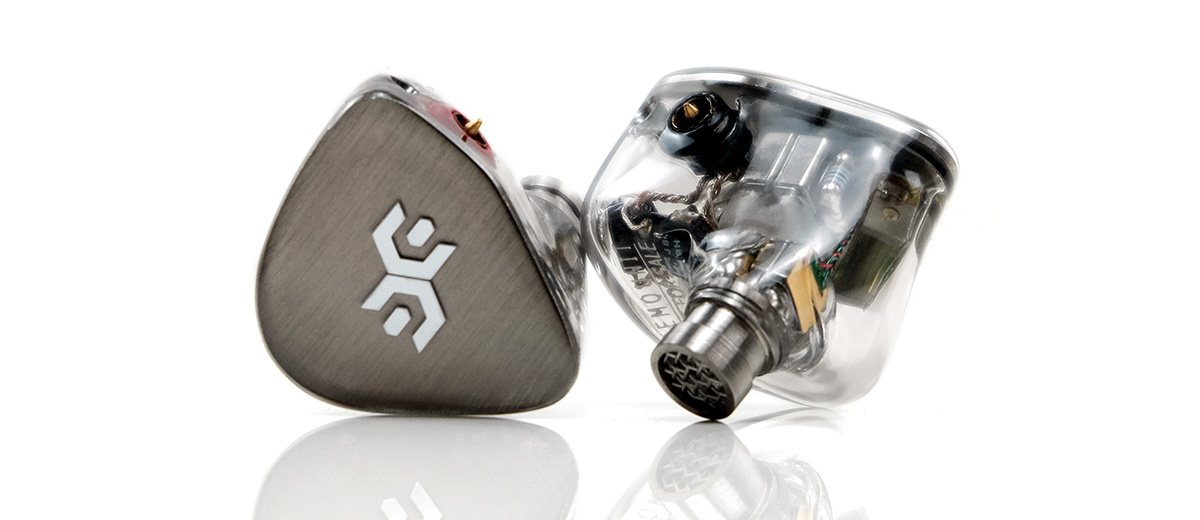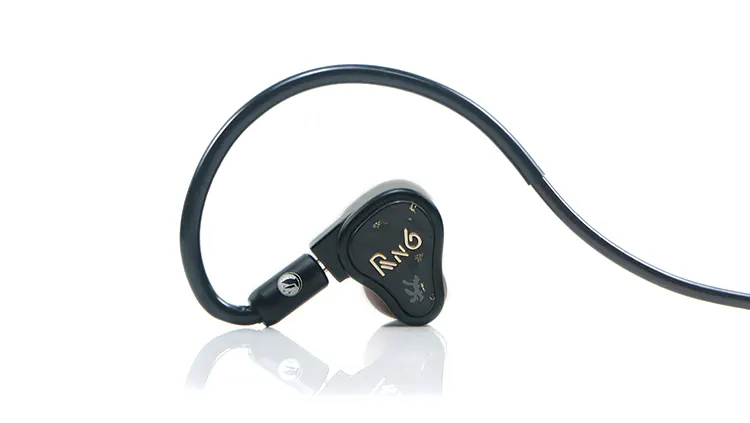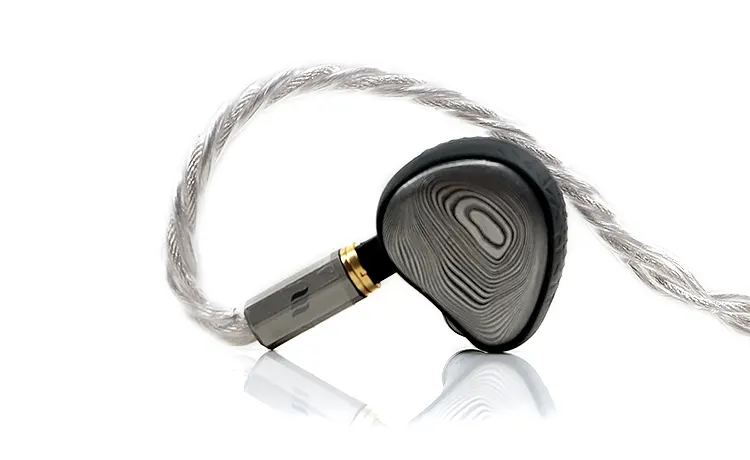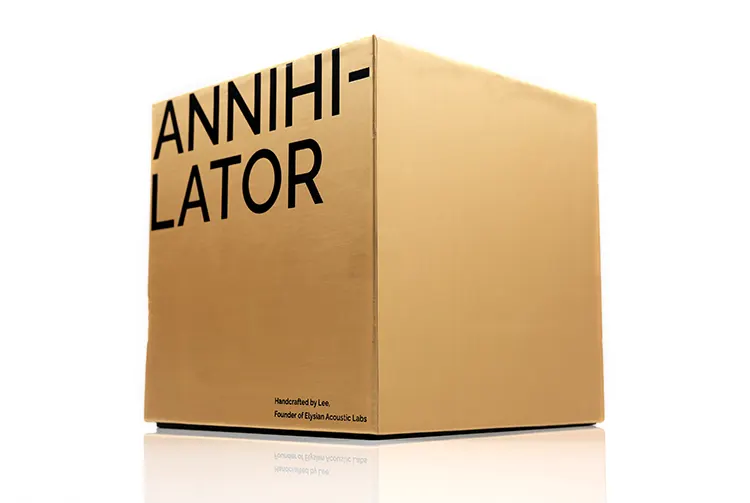Select Comparisons
The following comparisons to the Elysian Acoustic Labs Annihilator 2023 were completed using the HiBy R8 II, the Cayin N8ii, and the iBasso DX320 MAX Ti for both source and amplification.
All IEMs were fitted with their stock 4.4mm balanced cables and sources set to a low gain mode with the HiBy R8 II set to Turbo Mode.
Vision Ears VE10
The Vision Ears VE10 was released at the tail end of 2023 with our review coming out a few weeks ago. This is the company’s flagship monitor for their VE line and is currently only in a universal format.
Technical
The VE10 is a hybrid multi-driver IEM as opposed to the Annihilator 2023’s tribrid configuration, lacking any electrostatic drivers.
Its configuration is a single 8mm dynamic driver for the lows, with a dual BA for the low mids, a dual for the mids, another for the mid/highs, and the super tweeter for the ultra-highs using a 5-way crossover. That is 10 in total.
The Annihilator is a little simpler with a 7-driver configuration consisting of a single Foster dynamic driver for the lows, 4 BA for the mids, and a set of dual Sonion electrostatic tweeters for the highs using a 4-way crossover.
Both IEMs have a focus on acoustics with the VE10 using a specially designed horn and geometric-shaped sound tubes from the drivers to extend the high-frequency range and minimize turbulence to reduce THD.
The Annihilator 2023 opts for an independent front and rear chamber DiVe Pass System for the dynamic driver venting with an additional 3D AccuPost System acoustic chamber for enhanced imaging and soundstage performance.
The VE10 is rated at 8.4Ω @1kHz and 118.6 dB @100mV@1KHz and should be considered the more sensitive of the two monitors given the Annihilator’s 94db @100mV @1khz rating and slightly higher load of 22Ω.
Design
The VE10 is one of Vision Ears’ more unusual designs. Not so much in the shape and aesthetics but rather in the use of sturdy aluminum materials as opposed to resin or acrylic which has been a staple in their lineup since time began.
That does mean that despite being a noticeably slimmer IEM compared to the Annihilator 2023 it does feel a little bit heavier and denser to the touch. The Annihilator 2023 is the bigger of the two IEMs but I find it just slightly more comfortable in my ears because of the softer feel of the shell finish.
However, the VE10 does seem to hug the ear canal exit a bit better and seems to penetrate a bit more leaving me with a feeling that it isolates a bit better compared to the Annihilator.
The gap between them is tiny though for passive isolation, both are vented hybrid models so they are not class-leading here compared to all-BA non-vented designs.
The aesthetics between these two is quite striking. I would classify the Annihilator 2023 as more old school with the added transparent shell to look at the internals contributing much to the design. The VE10 is the more striking of the two with its two-tone aluminum and black shell cyber-punk theme.
Both companies have put a lot of work into their stock cables for these IEMs. The VE10 cable is 21AWG Silver Plated over 6NOCC copper with a Golden ratio and custom Litz structure geometry.
It is a bigger gauge than the Annihilator 2023 Liquid Links 8-wire 26AWG palladium-plated silver and gold-plated copper but I believe it might be just 4-wire as opposed to the Martini’s 8-wire geometry.
Performance
Both IEMs follow a similar formula with uplifted lows and good midrange presence. Hence, it’s more about how much more of an uplift with the Annihilator 2023 and the influence of those EST tweeters that make up for many of the differences.
On a high level, the VE10 is smoother, more relaxed sounding, and with a more rounded staging quality to its presentation.
The Annihilator 2023 has a more exaggerated frequency response delivering more emphasis on the extremes with a stronger sub-bass presence, enhanced upper-mids, and extended upper-treble energy or presence.
The exaggeration though equally applies to the dips with the Annihilator 2023 flatter through the upper bass and lower mids giving the listener a stronger perception of bass-to-mids separation and slightly less note body through this region.
It also means the Annihilator 2023 timbre has more contrast, with a stronger fundamental but also more treble overtone giving it plenty of power but also a lighter midrange coloration.
Though lacking in the same sub-bass rumble, the VE10 sounds a little richer and more euphonic through the midrange and vocal timbre.
The tuning differences also affect the perception of each IEM’s staging strengths. The Annihilator is more tall and deep and does sound airier with improved headroom. It will tease out a more energetic percussion and stronger higher-pitching vocal presence.
The VE10 is softer and less airy and sparkling through the highs but it does better for male vocal presence with a more intimate delivery and a stronger focus on the mids in general.
FiR Audio Radon 6
The FiR Audio Radon 6 was launched in the Spring of 2023 with our review coming out last summer. Initially launched on a limited run it also was awarded our 2023 Top Gear Award for Best Universal IEM.
Technical
Both of these IEMs are ‘tribrids’ with the Radon 6 using 6 drivers as opposed to 7 inside the Annihilator 2023.
Each monitor uses a single dynamic driver for the lows though for the Radon 6 this is a single Kinetic bass 10mm driver with unique properties. Armatures make up the mids with each monitor opting for 4. The Radon BA drivers are FiR’s own patented OpenDriver types which are tubeless by design.
The final driver type of the same for both though the Radon 6 uses only one Sonion Electrostatic driver for the ultra-highs which the Annihilator 2023 doubles up on with a dual tweeter for the same range.
A big sales point of the Radon 6 is the FIR Audio Kinetic bass technology which means a hybrid dynamic driver for both bone and traditional air conduction. You will notice it with a big fat grill or port on the underside of the Radon 6 shell as a big giveaway.
The second key feature is the use of the ATOM XS filter system which vents harmful air pressure out from a sealed ear canal with multiple variations able to not only affect the level of isolation but the tuning itself.
The Radon 6 has a 28Ω impedance rating but no official SPL so we can only subjectively compare it to the Annihilator 2023 using a common output platform.
With the HiBy R8 II using a balanced output in low-gain Turbo mode the Radon 6 was by far the more sensitive of the two with almost 20 steps between them to volume match.
Design
The Annihilator 2023 looks huge when sat beside the Radon 6. Despite the size, the Radon 6 is about equal to if not heavier than the Annihilator 2023 due to its use of aluminum for the shell instead of resin or acrylic.
The aesthetics are also hugely different with the Radon using a less revealing satin black finish to the 2-piece aluminum shell along with a creative and unique mix of gold flakes under a sapphire crystal glass face plate. The Annihilator 2023 is all about showing off the internals alongside a simpler brushed titanium plate on top.
Given the different sizing, the smaller Radon 6 does feel a little more secure though for some, the aluminum shell might pose temperature issues on cold days in the ear.
Isolation for both is about even depending on the tip choice and ATOM XS filter you use with the Radon 6. The Radon 6 Symbios hybrid tips do seal a bit more than the Annihilator 2023’s softer SpinFit variants but I find them less comfortable for prolonged use.
The Radon 6 stock cable is a fair bit lighter with a darker lower profile compared to the Annihilator 2023’s striking Liquid Links Martini cable.
This is a balanced terminated 48″ 26AWG 8-wire geometry with pure silver and copper shielding inside a slick-looking, dark, brown-toned braided PVC jacket, and a 4.4mm gold-plated branded Pentaconn plug.
It’s the polar opposite of the chrome and shine of the Martini aesthetics and with slightly stiffer handling but like the Martini it is also a quiet performer for microphonics.
Performance
Both monitors follow a similar path on paper with bass emphasis, lifted mids, and a nice extended treble but subjectively I find them to sound quite different.
One of the first things that will leap out is the quality of the bass and where each monitor seems to focus. The Annihilator 2023 is more about sub-bass power and depth whereas the Radon 6 shifts it up a little more to create a more concussive mid-bass performance.
As such the Annihilator 2023 reaches deeper and sounds the fuller of the two but has less impact and does not sound quite as physical on the same dynamic peaks as the Radon 6.
The second qualitative difference is the Radon 6’s subtle upper bass to lower mids lift which might not seem huge on paper but does help to inject a little more warmth into the midrange timbre.
The Annihilator’s mids are considerably more amplified but sound more neutral in coloration with slightly less body. There is also a bit more treble influence in the mids compared to the Radon 6’s more rounded tonal quality.
The final noticeable difference is in the imaging and general staging shape. I felt the Radon 6 produced a more intimate soundstage but to be seen as a whole rather than any one unique aspect.
A good example is Barbara Weldon’s stripped-down vocal and piano mixes on Le grand H de l’homme. With the Radon 6, her positioning was more beside the piano cabaret style with both competing within a slightly smaller stage.
With Annihilator, Barbara was upfront on her own in front of the mic and you are right there in row 1. However, the instruments are much further back so whilst very clean and clear they are positioned further behind the vocals.
Noble Audio Viking Ragnar
The Noble Audio Viking Ragnar was launched in late 2022 and is their flagship wired universal format, in-ear monitor. It was also the Top Gear Best Universal IEM awardee for that same year.
Technical
Like the Annihilator 2023, the Ragnar is also a tribrid mix of dynamic, balanced armatures, and electrostatic with 4-way crossovers but this time 10 drivers in total rather than 7.
The precise configuration for the Ragnar is a dual 10mm dynamic driver setup for the lows rather than the Annihilator 2023’s single Foster dynamic driver. The BA count is similar at 4 for each with a dual BA for the mids, and dual BA for the mid-highs.
Both IEMs use electrostatic arrays for the highs though the Ragnar doubles up with a quad-array as opposed to dual Sonion electrostatic drivers for the Annihilator 2023.
The Viking Ragnar is rated at a reasonably 17Ω impedance and 112dB sensitivity @1Khz though no mention from Noble of mW or Vrms. If we are working on Vrms then the Annihilator is less sensitive on paper at 94db @100mV @1khz with a slightly higher 22Ω impedance rating.
Indeed, with the HiBy R8 II as the main source output working out of a low gain balanced connection, the Annihilator was less sensitive compared to the Ragnar by around 6-7 digital volume steps.
Design
They have very different designs but similar form factors and are quite close in size meaning both should be classified as larger than average-sized IEMs.
Aesthetically, the Viking Ragnar Chris Ploof partnership is a high-end boutique creation with an exotic mix of Damascus steel for the plates combined with ribbed shells cut from a single aluminum block and finished with a delicate rune letter sequence on the side.
This is where that premium for the Ragnar seems to be going and it does make the Annihilator look plainer despite its interesting transparent internal aesthetic.
I do give an edge to the Annihilator 2023 for comfort because of the additional weight from the Ragnar which is readily felt in the ear canal combined with a rougher texture from the shell.
However, I am a fan of the fitting of the Ragnar’s extra-long nozzles which can be inserted deep with the right tip creating a very secure fit.
Now, with stock foam tips the fit is not as secure and so I usually end up with SpinFit or Final E tip on the Ragnar. If you compare stock foam Ragnar to stock SpinFit Annihilator 2023 then it’s even for isolation.
Both IEMs come with aftermarket 3rd party cables though the Ragnar Magnus cable is bespoke made by Wagnus of Japan and not an off-the-shelf cable.
The Magnus is a 4-wire as opposed to the Annihilator 2023’s Liquid Links 8-wire and perhaps overall a little less flashy when placed side by side. That being said it is a bit lighter and more malleable though neither has any issues with microphonics.
Both come with 4.4mm balanced as standard options though its Pentaconn connectors for the Annihilator 2023 and 2-pin 0.78mm for the Ragnar.
Performance
In a nutshell, the Annihilator 2023 has the timbre that I wish I could get from the Viking Ragnar but the Ragnar has the edge for control, and staging expanse, over the Annihilator 2023.
Pros of both? The Annihilator is smoother sounding through the mids, more voluptuous on the lows, generates more power, and is by far the easier of the two for source and genre matching.
It’s fabulous for modern pop, synthwave, and higher-pitching vocal performances where you want to reduce the potential for fatigue.
The Viking Ragnar is more expansive, more open through the mids, and more controlled on the lows but with a lot more treble presence from 5-10k giving it a brighter and cleaner tonal quality.
It does an incredible job with both macro and micro-detail, teasing out higher-pitching spatial cues with ease and an almost mini-HD800-like staging quality.
Cons of both? Sometimes the Annihilator 2023’s bass energy can dominate the lower mids and mask a bit of detail and energy with more bloom than the Ragnar. The Noble tuning keeps the bass more controlled and creates more space for the mids to resonate a bit more despite the more neutral midrange imaging.
The Ragnar’s weak spot for some will be that post-5k treble lift which is quite strong. It colors the upper mids and percussion with a sharpness that can be more fatiguing with the wrong tip and cable choice.
The Ragnar stock cable works well for dynamics on the lows but I tend to work Final E tips into the setup for the enhanced bass they provide over the stock foam tips. Still not as strong or full sounding as the Annihilator 2023 but a definite improvement.
Our Verdict
The Elysian Acoustic Labs Annihilator 2023 is one seriously high-performing in-ear monitor. It is also a benchmark for me regarding just how electrostatic drivers should sound in a high-end IEM.
More than just speedy sparkling highs, you get power, dynamics, and a bit of ‘fun’ thrown into the tuning giving it some high energy and excitement to go along with the technical excellence.
Is it the best of the best? Some competitors will disagree with the Radon 6’s mid-bass slamming harder and the Viking Ragnar generating more mid-range space. Variety is the spice of life.
However, for treble-heads, the Annihilator 2023 does it best for me, at least thus far. It’s a unique and very competitive offering from an indie brand that up until a few months before CanJam Singapore 2023, I had never really thought about before. I most certainly do now.
Elysian Acoustic Labs Annihilator 2023 Specifications
- 7 Drivers Tribrid Configuration
- 1 x Foster Dynamic Driver
- 2 x Electrostatic Tweeter
- 4 x Balanced Armature Drivers
- 4-way Crossover
- Frequency Response 20hz – 45khz
- Sensitivity 94 dB @100mV @1khz
- Impedance 22Ω @ 1khz





